Nursing Report: Evaluation of Chest Pain Management in CCU, Mr. A
VerifiedAdded on 2020/05/08
|11
|3300
|64
Report
AI Summary
This nursing report critically evaluates the nursing and collaborative interventions implemented for an 80-year-old male patient, Mr. A, admitted to the CCU with complicated angina and unexpected pulmonary edema. The report details the patient's journey through triage, diagnosis, treatment, observation, and follow-up, focusing on chest pain management. It emphasizes the use of the PQRST method for pain assessment, positioning, and the administration of GTN and morphine. The report also highlights the importance of ECG for diagnosis and collaborative interventions. Furthermore, the report discusses alternative interventions like oxygenation and thrombectomy, while also reflecting on the nursing practice, challenges faced, and areas for future development. References support the evidence-based approach to patient care, focusing on effective communication, collaboration, and the use of assessment tools to improve patient outcomes.
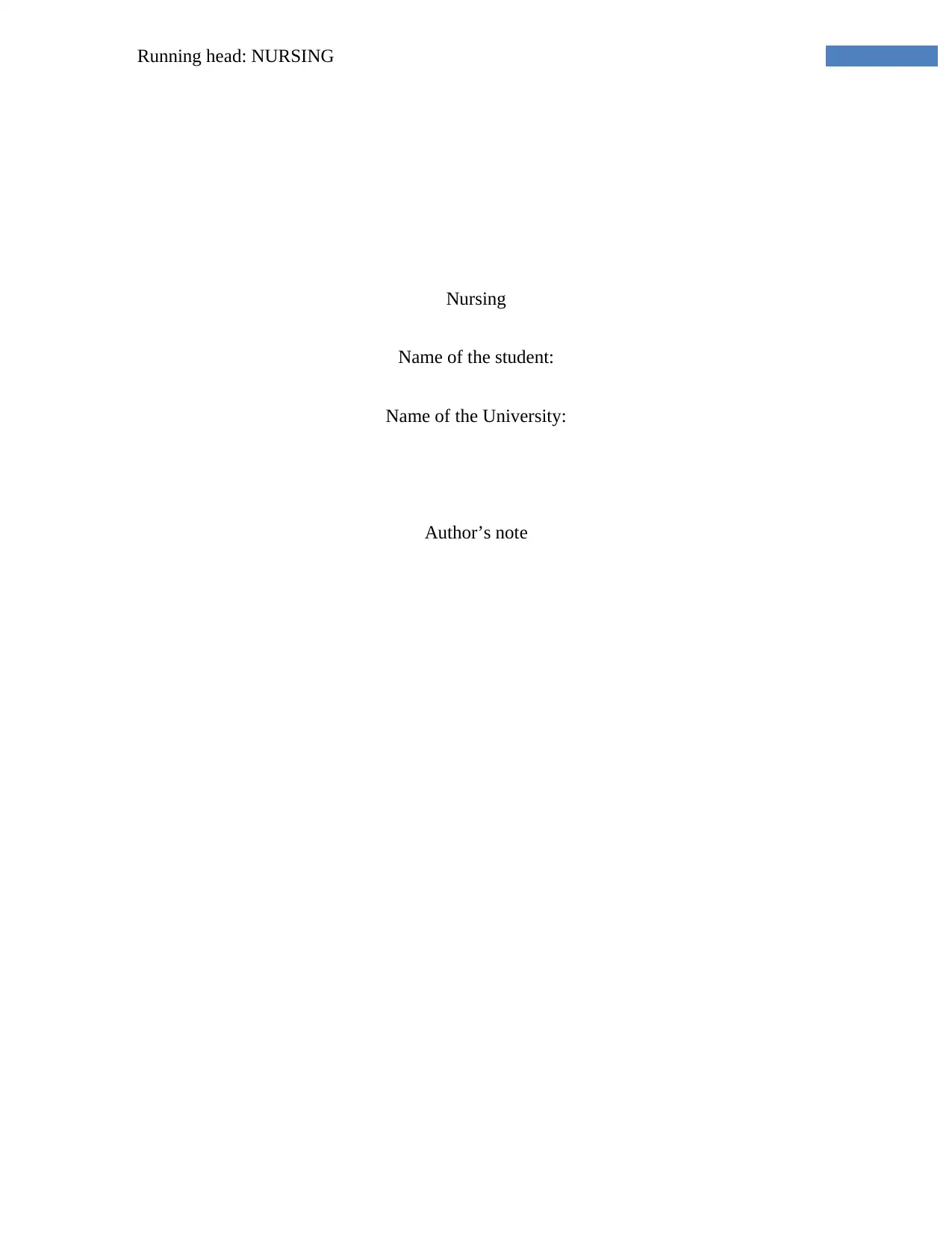
Running head: NURSING
Nursing
Name of the student:
Name of the University:
Author’s note
Nursing
Name of the student:
Name of the University:
Author’s note
Paraphrase This Document
Need a fresh take? Get an instant paraphrase of this document with our AI Paraphraser
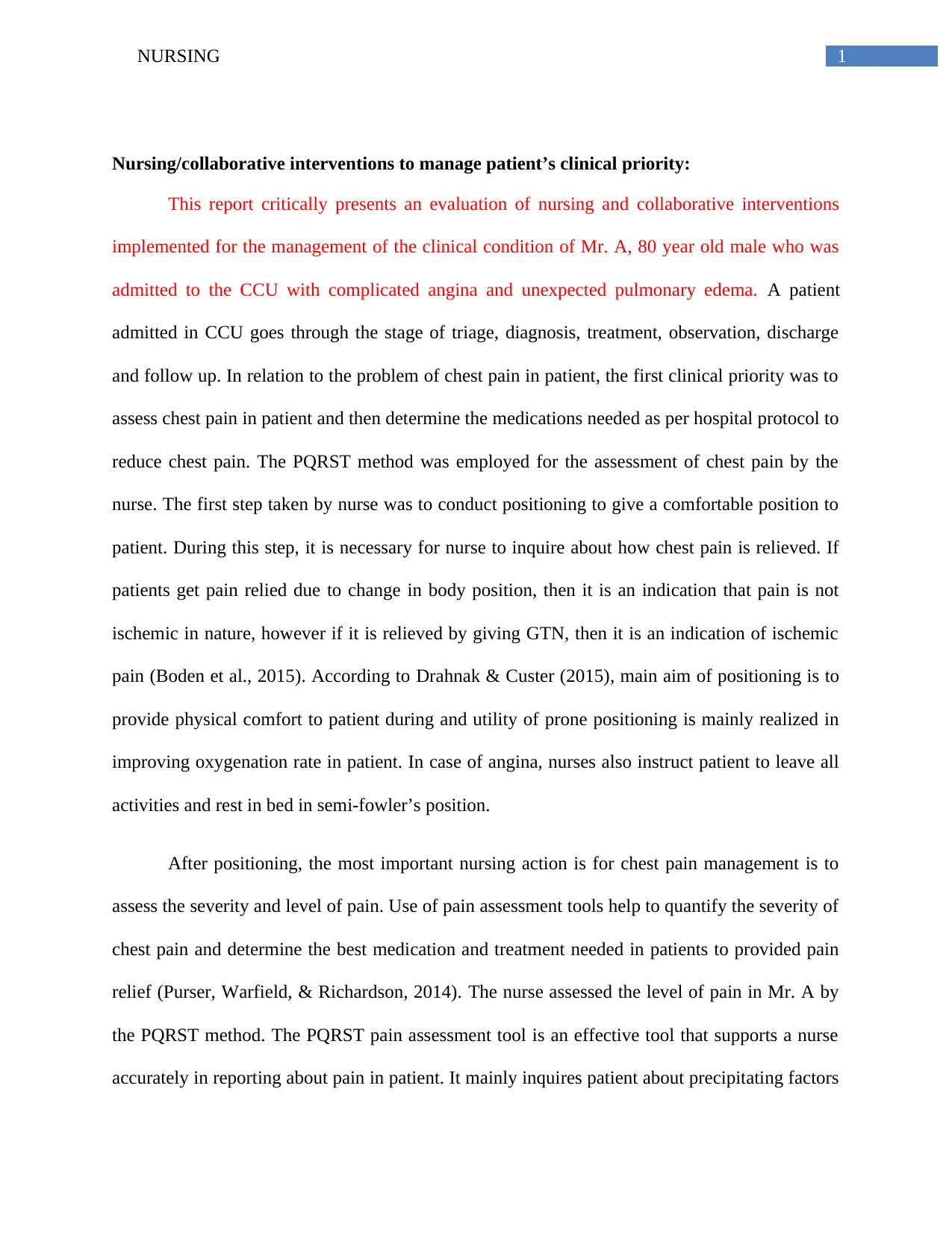
1NURSING
Nursing/collaborative interventions to manage patient’s clinical priority:
This report critically presents an evaluation of nursing and collaborative interventions
implemented for the management of the clinical condition of Mr. A, 80 year old male who was
admitted to the CCU with complicated angina and unexpected pulmonary edema. A patient
admitted in CCU goes through the stage of triage, diagnosis, treatment, observation, discharge
and follow up. In relation to the problem of chest pain in patient, the first clinical priority was to
assess chest pain in patient and then determine the medications needed as per hospital protocol to
reduce chest pain. The PQRST method was employed for the assessment of chest pain by the
nurse. The first step taken by nurse was to conduct positioning to give a comfortable position to
patient. During this step, it is necessary for nurse to inquire about how chest pain is relieved. If
patients get pain relied due to change in body position, then it is an indication that pain is not
ischemic in nature, however if it is relieved by giving GTN, then it is an indication of ischemic
pain (Boden et al., 2015). According to Drahnak & Custer (2015), main aim of positioning is to
provide physical comfort to patient during and utility of prone positioning is mainly realized in
improving oxygenation rate in patient. In case of angina, nurses also instruct patient to leave all
activities and rest in bed in semi-fowler’s position.
After positioning, the most important nursing action is for chest pain management is to
assess the severity and level of pain. Use of pain assessment tools help to quantify the severity of
chest pain and determine the best medication and treatment needed in patients to provided pain
relief (Purser, Warfield, & Richardson, 2014). The nurse assessed the level of pain in Mr. A by
the PQRST method. The PQRST pain assessment tool is an effective tool that supports a nurse
accurately in reporting about pain in patient. It mainly inquires patient about precipitating factors
Nursing/collaborative interventions to manage patient’s clinical priority:
This report critically presents an evaluation of nursing and collaborative interventions
implemented for the management of the clinical condition of Mr. A, 80 year old male who was
admitted to the CCU with complicated angina and unexpected pulmonary edema. A patient
admitted in CCU goes through the stage of triage, diagnosis, treatment, observation, discharge
and follow up. In relation to the problem of chest pain in patient, the first clinical priority was to
assess chest pain in patient and then determine the medications needed as per hospital protocol to
reduce chest pain. The PQRST method was employed for the assessment of chest pain by the
nurse. The first step taken by nurse was to conduct positioning to give a comfortable position to
patient. During this step, it is necessary for nurse to inquire about how chest pain is relieved. If
patients get pain relied due to change in body position, then it is an indication that pain is not
ischemic in nature, however if it is relieved by giving GTN, then it is an indication of ischemic
pain (Boden et al., 2015). According to Drahnak & Custer (2015), main aim of positioning is to
provide physical comfort to patient during and utility of prone positioning is mainly realized in
improving oxygenation rate in patient. In case of angina, nurses also instruct patient to leave all
activities and rest in bed in semi-fowler’s position.
After positioning, the most important nursing action is for chest pain management is to
assess the severity and level of pain. Use of pain assessment tools help to quantify the severity of
chest pain and determine the best medication and treatment needed in patients to provided pain
relief (Purser, Warfield, & Richardson, 2014). The nurse assessed the level of pain in Mr. A by
the PQRST method. The PQRST pain assessment tool is an effective tool that supports a nurse
accurately in reporting about pain in patient. It mainly inquires patient about precipitating factors
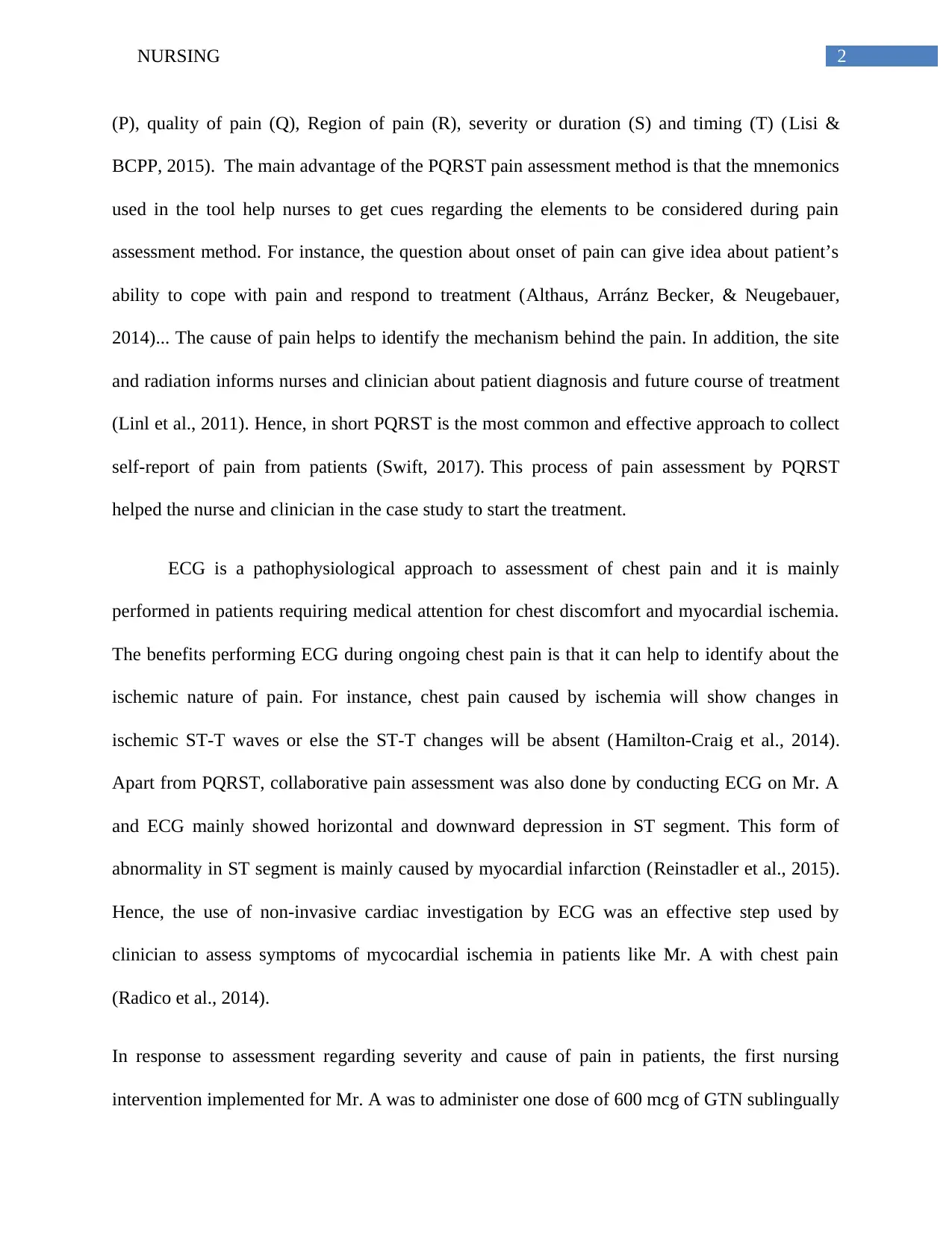
2NURSING
(P), quality of pain (Q), Region of pain (R), severity or duration (S) and timing (T) (Lisi &
BCPP, 2015). The main advantage of the PQRST pain assessment method is that the mnemonics
used in the tool help nurses to get cues regarding the elements to be considered during pain
assessment method. For instance, the question about onset of pain can give idea about patient’s
ability to cope with pain and respond to treatment (Althaus, Arránz Becker, & Neugebauer,
2014)... The cause of pain helps to identify the mechanism behind the pain. In addition, the site
and radiation informs nurses and clinician about patient diagnosis and future course of treatment
(Linl et al., 2011). Hence, in short PQRST is the most common and effective approach to collect
self-report of pain from patients (Swift, 2017). This process of pain assessment by PQRST
helped the nurse and clinician in the case study to start the treatment.
ECG is a pathophysiological approach to assessment of chest pain and it is mainly
performed in patients requiring medical attention for chest discomfort and myocardial ischemia.
The benefits performing ECG during ongoing chest pain is that it can help to identify about the
ischemic nature of pain. For instance, chest pain caused by ischemia will show changes in
ischemic ST-T waves or else the ST-T changes will be absent (Hamilton-Craig et al., 2014).
Apart from PQRST, collaborative pain assessment was also done by conducting ECG on Mr. A
and ECG mainly showed horizontal and downward depression in ST segment. This form of
abnormality in ST segment is mainly caused by myocardial infarction (Reinstadler et al., 2015).
Hence, the use of non-invasive cardiac investigation by ECG was an effective step used by
clinician to assess symptoms of mycocardial ischemia in patients like Mr. A with chest pain
(Radico et al., 2014).
In response to assessment regarding severity and cause of pain in patients, the first nursing
intervention implemented for Mr. A was to administer one dose of 600 mcg of GTN sublingually
(P), quality of pain (Q), Region of pain (R), severity or duration (S) and timing (T) (Lisi &
BCPP, 2015). The main advantage of the PQRST pain assessment method is that the mnemonics
used in the tool help nurses to get cues regarding the elements to be considered during pain
assessment method. For instance, the question about onset of pain can give idea about patient’s
ability to cope with pain and respond to treatment (Althaus, Arránz Becker, & Neugebauer,
2014)... The cause of pain helps to identify the mechanism behind the pain. In addition, the site
and radiation informs nurses and clinician about patient diagnosis and future course of treatment
(Linl et al., 2011). Hence, in short PQRST is the most common and effective approach to collect
self-report of pain from patients (Swift, 2017). This process of pain assessment by PQRST
helped the nurse and clinician in the case study to start the treatment.
ECG is a pathophysiological approach to assessment of chest pain and it is mainly
performed in patients requiring medical attention for chest discomfort and myocardial ischemia.
The benefits performing ECG during ongoing chest pain is that it can help to identify about the
ischemic nature of pain. For instance, chest pain caused by ischemia will show changes in
ischemic ST-T waves or else the ST-T changes will be absent (Hamilton-Craig et al., 2014).
Apart from PQRST, collaborative pain assessment was also done by conducting ECG on Mr. A
and ECG mainly showed horizontal and downward depression in ST segment. This form of
abnormality in ST segment is mainly caused by myocardial infarction (Reinstadler et al., 2015).
Hence, the use of non-invasive cardiac investigation by ECG was an effective step used by
clinician to assess symptoms of mycocardial ischemia in patients like Mr. A with chest pain
(Radico et al., 2014).
In response to assessment regarding severity and cause of pain in patients, the first nursing
intervention implemented for Mr. A was to administer one dose of 600 mcg of GTN sublingually
⊘ This is a preview!⊘
Do you want full access?
Subscribe today to unlock all pages.

Trusted by 1+ million students worldwide
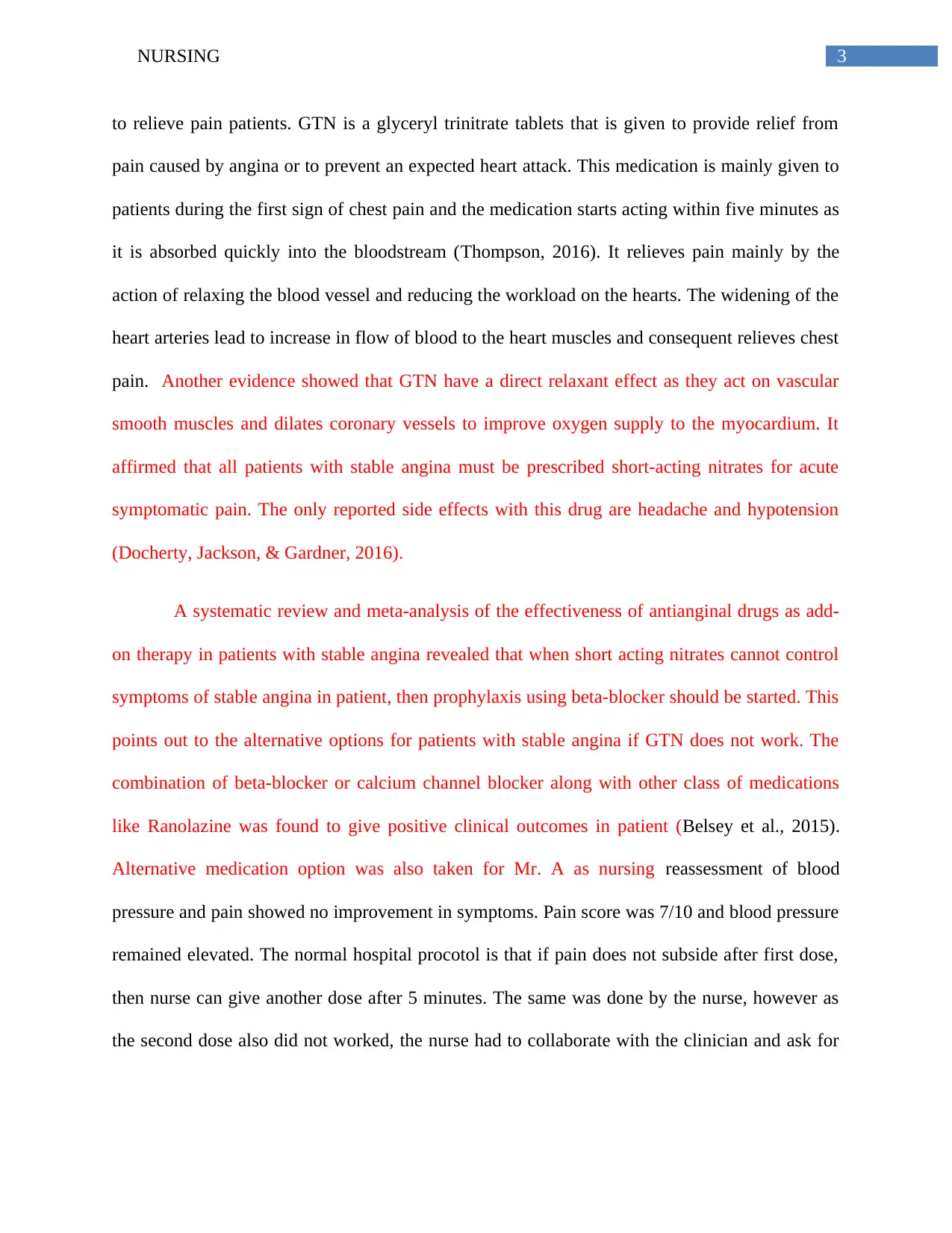
3NURSING
to relieve pain patients. GTN is a glyceryl trinitrate tablets that is given to provide relief from
pain caused by angina or to prevent an expected heart attack. This medication is mainly given to
patients during the first sign of chest pain and the medication starts acting within five minutes as
it is absorbed quickly into the bloodstream (Thompson, 2016). It relieves pain mainly by the
action of relaxing the blood vessel and reducing the workload on the hearts. The widening of the
heart arteries lead to increase in flow of blood to the heart muscles and consequent relieves chest
pain. Another evidence showed that GTN have a direct relaxant effect as they act on vascular
smooth muscles and dilates coronary vessels to improve oxygen supply to the myocardium. It
affirmed that all patients with stable angina must be prescribed short-acting nitrates for acute
symptomatic pain. The only reported side effects with this drug are headache and hypotension
(Docherty, Jackson, & Gardner, 2016).
A systematic review and meta-analysis of the effectiveness of antianginal drugs as add-
on therapy in patients with stable angina revealed that when short acting nitrates cannot control
symptoms of stable angina in patient, then prophylaxis using beta-blocker should be started. This
points out to the alternative options for patients with stable angina if GTN does not work. The
combination of beta-blocker or calcium channel blocker along with other class of medications
like Ranolazine was found to give positive clinical outcomes in patient (Belsey et al., 2015).
Alternative medication option was also taken for Mr. A as nursing reassessment of blood
pressure and pain showed no improvement in symptoms. Pain score was 7/10 and blood pressure
remained elevated. The normal hospital procotol is that if pain does not subside after first dose,
then nurse can give another dose after 5 minutes. The same was done by the nurse, however as
the second dose also did not worked, the nurse had to collaborate with the clinician and ask for
to relieve pain patients. GTN is a glyceryl trinitrate tablets that is given to provide relief from
pain caused by angina or to prevent an expected heart attack. This medication is mainly given to
patients during the first sign of chest pain and the medication starts acting within five minutes as
it is absorbed quickly into the bloodstream (Thompson, 2016). It relieves pain mainly by the
action of relaxing the blood vessel and reducing the workload on the hearts. The widening of the
heart arteries lead to increase in flow of blood to the heart muscles and consequent relieves chest
pain. Another evidence showed that GTN have a direct relaxant effect as they act on vascular
smooth muscles and dilates coronary vessels to improve oxygen supply to the myocardium. It
affirmed that all patients with stable angina must be prescribed short-acting nitrates for acute
symptomatic pain. The only reported side effects with this drug are headache and hypotension
(Docherty, Jackson, & Gardner, 2016).
A systematic review and meta-analysis of the effectiveness of antianginal drugs as add-
on therapy in patients with stable angina revealed that when short acting nitrates cannot control
symptoms of stable angina in patient, then prophylaxis using beta-blocker should be started. This
points out to the alternative options for patients with stable angina if GTN does not work. The
combination of beta-blocker or calcium channel blocker along with other class of medications
like Ranolazine was found to give positive clinical outcomes in patient (Belsey et al., 2015).
Alternative medication option was also taken for Mr. A as nursing reassessment of blood
pressure and pain showed no improvement in symptoms. Pain score was 7/10 and blood pressure
remained elevated. The normal hospital procotol is that if pain does not subside after first dose,
then nurse can give another dose after 5 minutes. The same was done by the nurse, however as
the second dose also did not worked, the nurse had to collaborate with the clinician and ask for
Paraphrase This Document
Need a fresh take? Get an instant paraphrase of this document with our AI Paraphraser
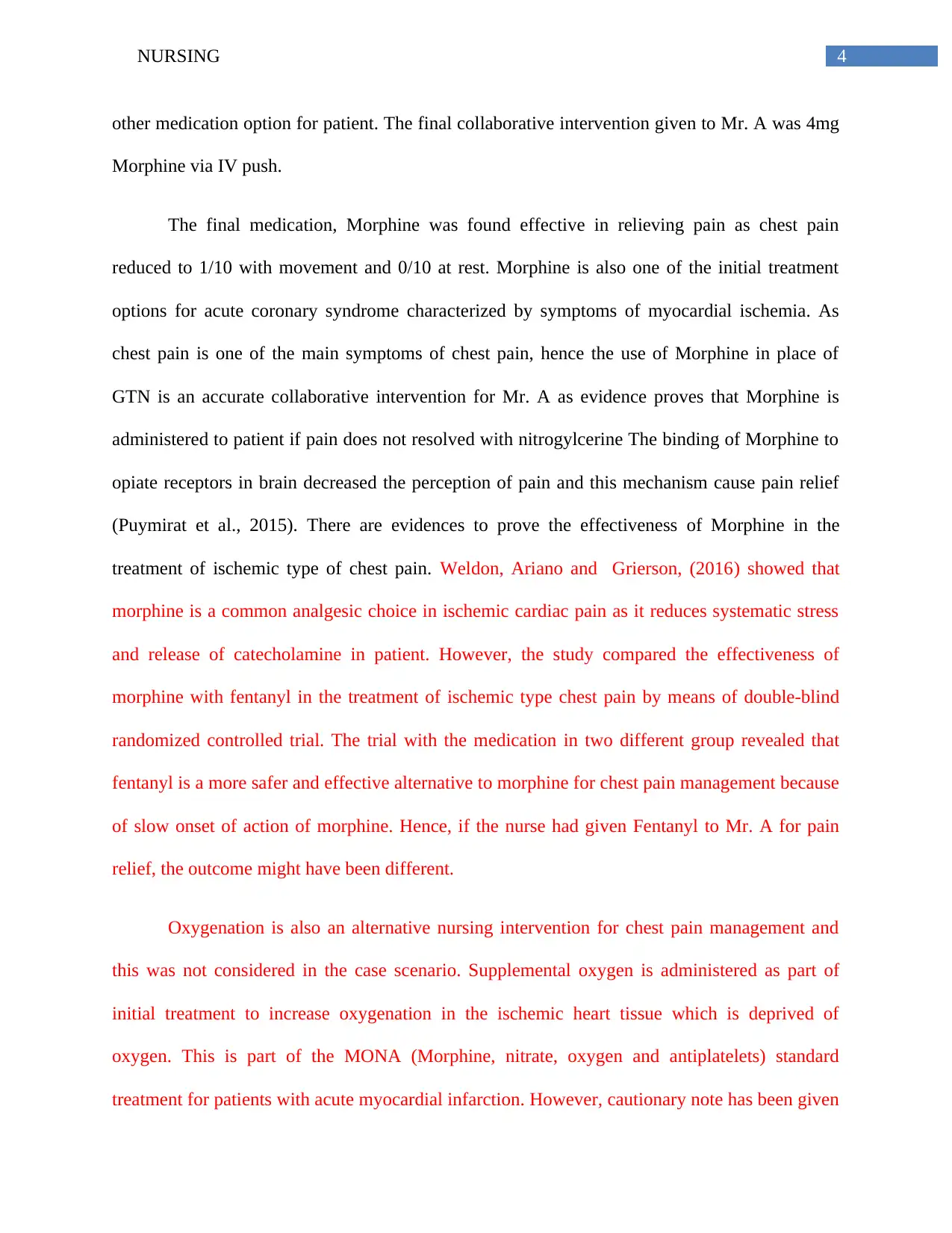
4NURSING
other medication option for patient. The final collaborative intervention given to Mr. A was 4mg
Morphine via IV push.
The final medication, Morphine was found effective in relieving pain as chest pain
reduced to 1/10 with movement and 0/10 at rest. Morphine is also one of the initial treatment
options for acute coronary syndrome characterized by symptoms of myocardial ischemia. As
chest pain is one of the main symptoms of chest pain, hence the use of Morphine in place of
GTN is an accurate collaborative intervention for Mr. A as evidence proves that Morphine is
administered to patient if pain does not resolved with nitrogylcerine The binding of Morphine to
opiate receptors in brain decreased the perception of pain and this mechanism cause pain relief
(Puymirat et al., 2015). There are evidences to prove the effectiveness of Morphine in the
treatment of ischemic type of chest pain. Weldon, Ariano and Grierson, (2016) showed that
morphine is a common analgesic choice in ischemic cardiac pain as it reduces systematic stress
and release of catecholamine in patient. However, the study compared the effectiveness of
morphine with fentanyl in the treatment of ischemic type chest pain by means of double-blind
randomized controlled trial. The trial with the medication in two different group revealed that
fentanyl is a more safer and effective alternative to morphine for chest pain management because
of slow onset of action of morphine. Hence, if the nurse had given Fentanyl to Mr. A for pain
relief, the outcome might have been different.
Oxygenation is also an alternative nursing intervention for chest pain management and
this was not considered in the case scenario. Supplemental oxygen is administered as part of
initial treatment to increase oxygenation in the ischemic heart tissue which is deprived of
oxygen. This is part of the MONA (Morphine, nitrate, oxygen and antiplatelets) standard
treatment for patients with acute myocardial infarction. However, cautionary note has been given
other medication option for patient. The final collaborative intervention given to Mr. A was 4mg
Morphine via IV push.
The final medication, Morphine was found effective in relieving pain as chest pain
reduced to 1/10 with movement and 0/10 at rest. Morphine is also one of the initial treatment
options for acute coronary syndrome characterized by symptoms of myocardial ischemia. As
chest pain is one of the main symptoms of chest pain, hence the use of Morphine in place of
GTN is an accurate collaborative intervention for Mr. A as evidence proves that Morphine is
administered to patient if pain does not resolved with nitrogylcerine The binding of Morphine to
opiate receptors in brain decreased the perception of pain and this mechanism cause pain relief
(Puymirat et al., 2015). There are evidences to prove the effectiveness of Morphine in the
treatment of ischemic type of chest pain. Weldon, Ariano and Grierson, (2016) showed that
morphine is a common analgesic choice in ischemic cardiac pain as it reduces systematic stress
and release of catecholamine in patient. However, the study compared the effectiveness of
morphine with fentanyl in the treatment of ischemic type chest pain by means of double-blind
randomized controlled trial. The trial with the medication in two different group revealed that
fentanyl is a more safer and effective alternative to morphine for chest pain management because
of slow onset of action of morphine. Hence, if the nurse had given Fentanyl to Mr. A for pain
relief, the outcome might have been different.
Oxygenation is also an alternative nursing intervention for chest pain management and
this was not considered in the case scenario. Supplemental oxygen is administered as part of
initial treatment to increase oxygenation in the ischemic heart tissue which is deprived of
oxygen. This is part of the MONA (Morphine, nitrate, oxygen and antiplatelets) standard
treatment for patients with acute myocardial infarction. However, cautionary note has been given
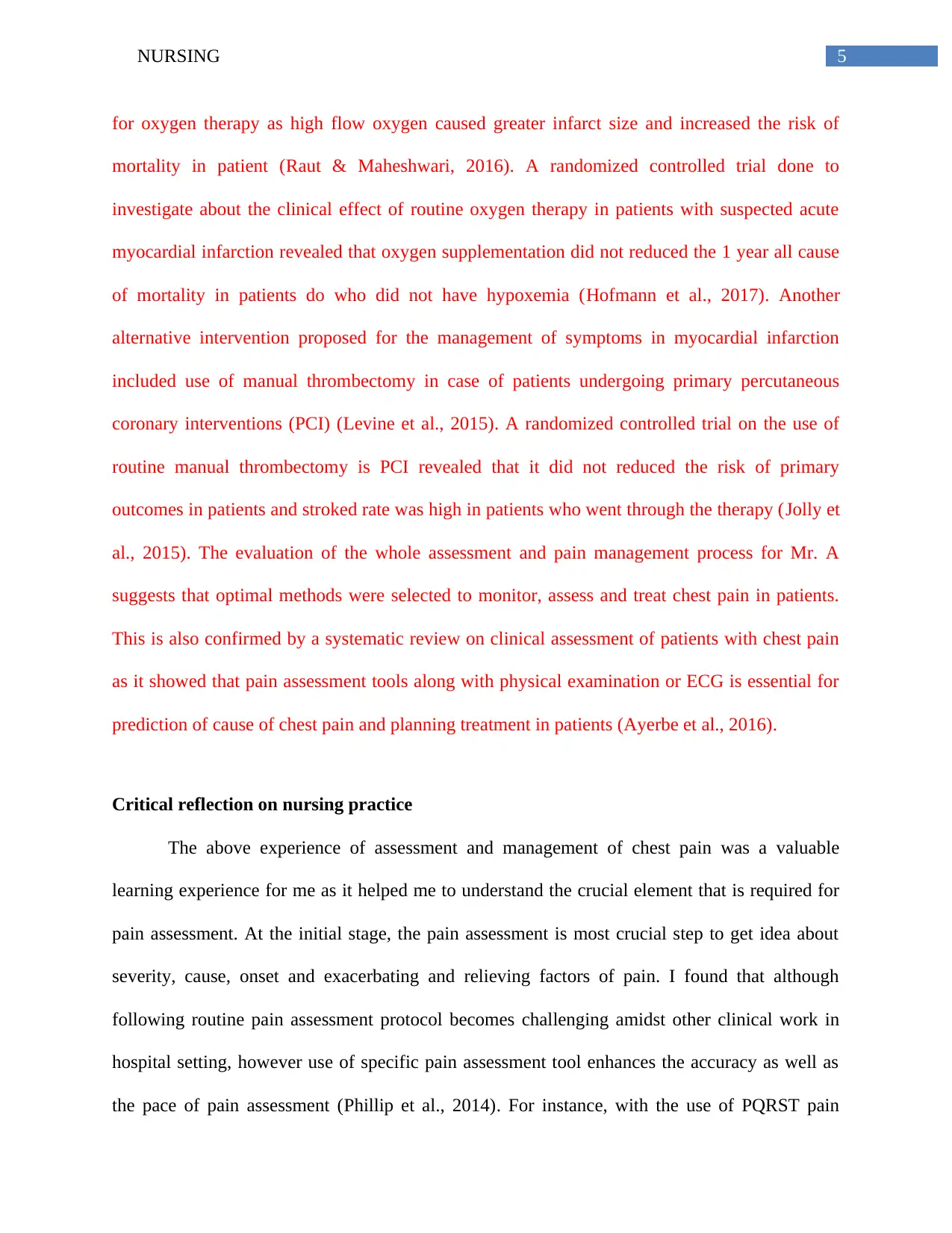
5NURSING
for oxygen therapy as high flow oxygen caused greater infarct size and increased the risk of
mortality in patient (Raut & Maheshwari, 2016). A randomized controlled trial done to
investigate about the clinical effect of routine oxygen therapy in patients with suspected acute
myocardial infarction revealed that oxygen supplementation did not reduced the 1 year all cause
of mortality in patients do who did not have hypoxemia (Hofmann et al., 2017). Another
alternative intervention proposed for the management of symptoms in myocardial infarction
included use of manual thrombectomy in case of patients undergoing primary percutaneous
coronary interventions (PCI) (Levine et al., 2015). A randomized controlled trial on the use of
routine manual thrombectomy is PCI revealed that it did not reduced the risk of primary
outcomes in patients and stroked rate was high in patients who went through the therapy (Jolly et
al., 2015). The evaluation of the whole assessment and pain management process for Mr. A
suggests that optimal methods were selected to monitor, assess and treat chest pain in patients.
This is also confirmed by a systematic review on clinical assessment of patients with chest pain
as it showed that pain assessment tools along with physical examination or ECG is essential for
prediction of cause of chest pain and planning treatment in patients (Ayerbe et al., 2016).
Critical reflection on nursing practice
The above experience of assessment and management of chest pain was a valuable
learning experience for me as it helped me to understand the crucial element that is required for
pain assessment. At the initial stage, the pain assessment is most crucial step to get idea about
severity, cause, onset and exacerbating and relieving factors of pain. I found that although
following routine pain assessment protocol becomes challenging amidst other clinical work in
hospital setting, however use of specific pain assessment tool enhances the accuracy as well as
the pace of pain assessment (Phillip et al., 2014). For instance, with the use of PQRST pain
for oxygen therapy as high flow oxygen caused greater infarct size and increased the risk of
mortality in patient (Raut & Maheshwari, 2016). A randomized controlled trial done to
investigate about the clinical effect of routine oxygen therapy in patients with suspected acute
myocardial infarction revealed that oxygen supplementation did not reduced the 1 year all cause
of mortality in patients do who did not have hypoxemia (Hofmann et al., 2017). Another
alternative intervention proposed for the management of symptoms in myocardial infarction
included use of manual thrombectomy in case of patients undergoing primary percutaneous
coronary interventions (PCI) (Levine et al., 2015). A randomized controlled trial on the use of
routine manual thrombectomy is PCI revealed that it did not reduced the risk of primary
outcomes in patients and stroked rate was high in patients who went through the therapy (Jolly et
al., 2015). The evaluation of the whole assessment and pain management process for Mr. A
suggests that optimal methods were selected to monitor, assess and treat chest pain in patients.
This is also confirmed by a systematic review on clinical assessment of patients with chest pain
as it showed that pain assessment tools along with physical examination or ECG is essential for
prediction of cause of chest pain and planning treatment in patients (Ayerbe et al., 2016).
Critical reflection on nursing practice
The above experience of assessment and management of chest pain was a valuable
learning experience for me as it helped me to understand the crucial element that is required for
pain assessment. At the initial stage, the pain assessment is most crucial step to get idea about
severity, cause, onset and exacerbating and relieving factors of pain. I found that although
following routine pain assessment protocol becomes challenging amidst other clinical work in
hospital setting, however use of specific pain assessment tool enhances the accuracy as well as
the pace of pain assessment (Phillip et al., 2014). For instance, with the use of PQRST pain
⊘ This is a preview!⊘
Do you want full access?
Subscribe today to unlock all pages.

Trusted by 1+ million students worldwide
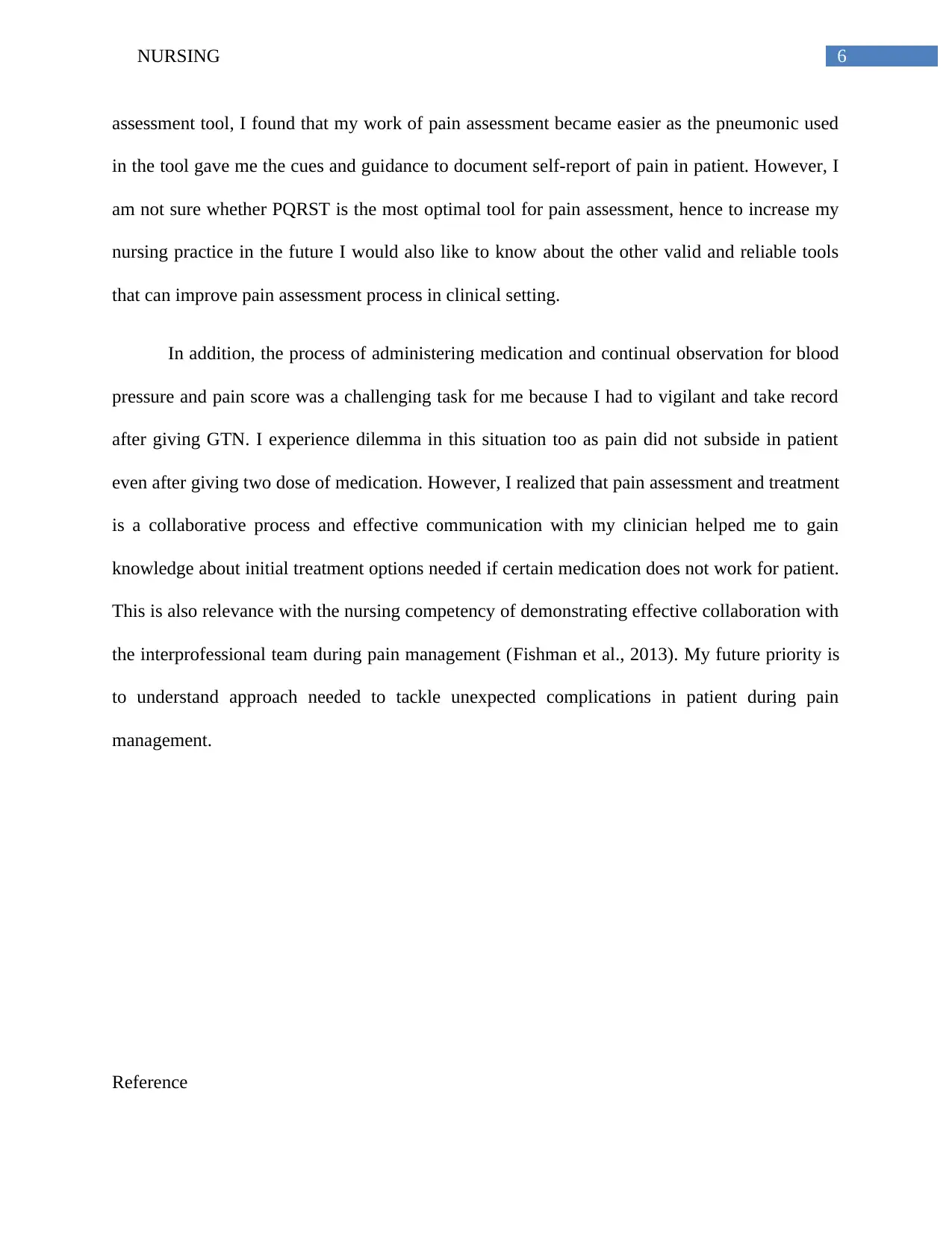
6NURSING
assessment tool, I found that my work of pain assessment became easier as the pneumonic used
in the tool gave me the cues and guidance to document self-report of pain in patient. However, I
am not sure whether PQRST is the most optimal tool for pain assessment, hence to increase my
nursing practice in the future I would also like to know about the other valid and reliable tools
that can improve pain assessment process in clinical setting.
In addition, the process of administering medication and continual observation for blood
pressure and pain score was a challenging task for me because I had to vigilant and take record
after giving GTN. I experience dilemma in this situation too as pain did not subside in patient
even after giving two dose of medication. However, I realized that pain assessment and treatment
is a collaborative process and effective communication with my clinician helped me to gain
knowledge about initial treatment options needed if certain medication does not work for patient.
This is also relevance with the nursing competency of demonstrating effective collaboration with
the interprofessional team during pain management (Fishman et al., 2013). My future priority is
to understand approach needed to tackle unexpected complications in patient during pain
management.
Reference
assessment tool, I found that my work of pain assessment became easier as the pneumonic used
in the tool gave me the cues and guidance to document self-report of pain in patient. However, I
am not sure whether PQRST is the most optimal tool for pain assessment, hence to increase my
nursing practice in the future I would also like to know about the other valid and reliable tools
that can improve pain assessment process in clinical setting.
In addition, the process of administering medication and continual observation for blood
pressure and pain score was a challenging task for me because I had to vigilant and take record
after giving GTN. I experience dilemma in this situation too as pain did not subside in patient
even after giving two dose of medication. However, I realized that pain assessment and treatment
is a collaborative process and effective communication with my clinician helped me to gain
knowledge about initial treatment options needed if certain medication does not work for patient.
This is also relevance with the nursing competency of demonstrating effective collaboration with
the interprofessional team during pain management (Fishman et al., 2013). My future priority is
to understand approach needed to tackle unexpected complications in patient during pain
management.
Reference
Paraphrase This Document
Need a fresh take? Get an instant paraphrase of this document with our AI Paraphraser
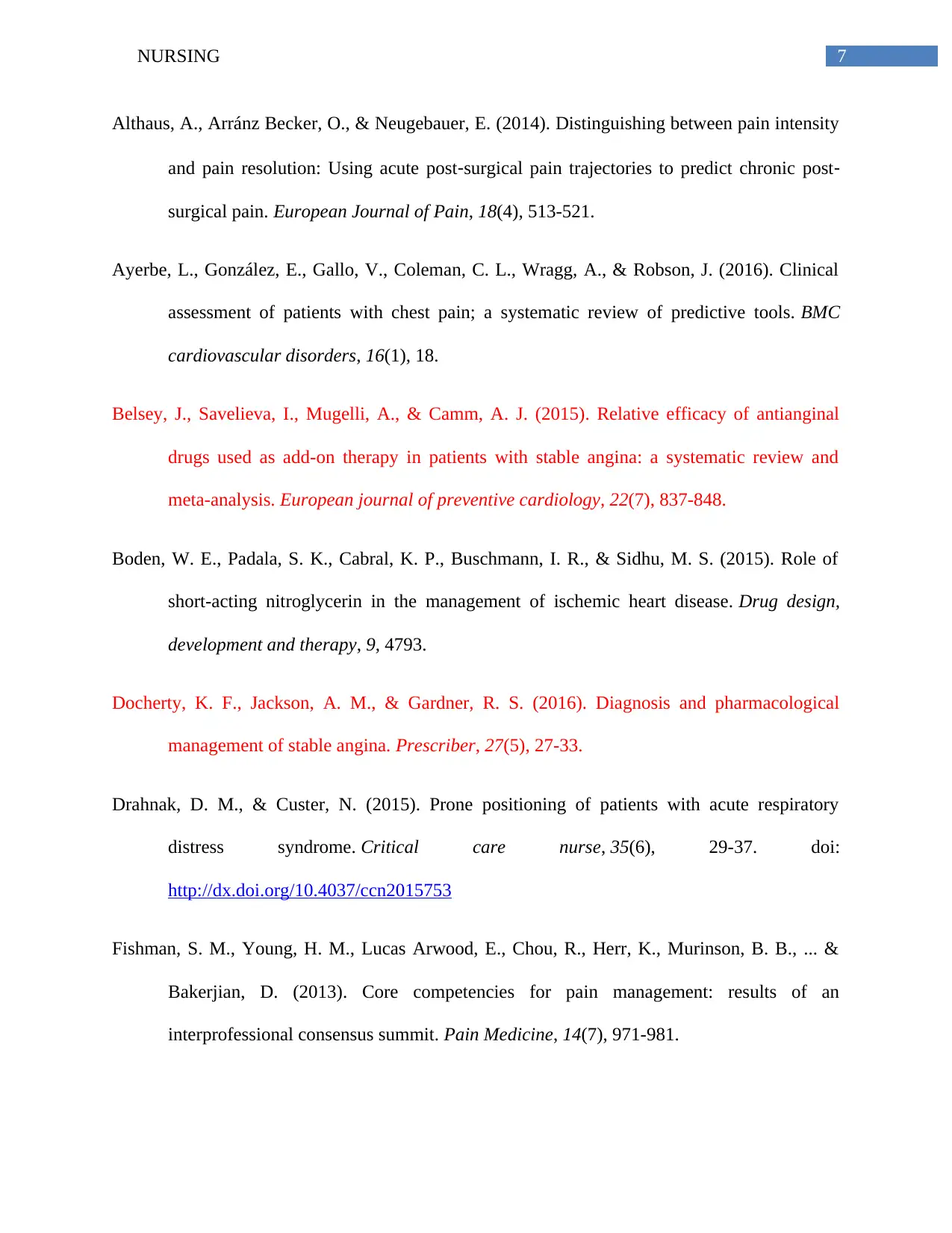
7NURSING
Althaus, A., Arránz Becker, O., & Neugebauer, E. (2014). Distinguishing between pain intensity
and pain resolution: Using acute post‐surgical pain trajectories to predict chronic post‐
surgical pain. European Journal of Pain, 18(4), 513-521.
Ayerbe, L., González, E., Gallo, V., Coleman, C. L., Wragg, A., & Robson, J. (2016). Clinical
assessment of patients with chest pain; a systematic review of predictive tools. BMC
cardiovascular disorders, 16(1), 18.
Belsey, J., Savelieva, I., Mugelli, A., & Camm, A. J. (2015). Relative efficacy of antianginal
drugs used as add-on therapy in patients with stable angina: a systematic review and
meta-analysis. European journal of preventive cardiology, 22(7), 837-848.
Boden, W. E., Padala, S. K., Cabral, K. P., Buschmann, I. R., & Sidhu, M. S. (2015). Role of
short-acting nitroglycerin in the management of ischemic heart disease. Drug design,
development and therapy, 9, 4793.
Docherty, K. F., Jackson, A. M., & Gardner, R. S. (2016). Diagnosis and pharmacological
management of stable angina. Prescriber, 27(5), 27-33.
Drahnak, D. M., & Custer, N. (2015). Prone positioning of patients with acute respiratory
distress syndrome. Critical care nurse, 35(6), 29-37. doi:
http://dx.doi.org/10.4037/ccn2015753
Fishman, S. M., Young, H. M., Lucas Arwood, E., Chou, R., Herr, K., Murinson, B. B., ... &
Bakerjian, D. (2013). Core competencies for pain management: results of an
interprofessional consensus summit. Pain Medicine, 14(7), 971-981.
Althaus, A., Arránz Becker, O., & Neugebauer, E. (2014). Distinguishing between pain intensity
and pain resolution: Using acute post‐surgical pain trajectories to predict chronic post‐
surgical pain. European Journal of Pain, 18(4), 513-521.
Ayerbe, L., González, E., Gallo, V., Coleman, C. L., Wragg, A., & Robson, J. (2016). Clinical
assessment of patients with chest pain; a systematic review of predictive tools. BMC
cardiovascular disorders, 16(1), 18.
Belsey, J., Savelieva, I., Mugelli, A., & Camm, A. J. (2015). Relative efficacy of antianginal
drugs used as add-on therapy in patients with stable angina: a systematic review and
meta-analysis. European journal of preventive cardiology, 22(7), 837-848.
Boden, W. E., Padala, S. K., Cabral, K. P., Buschmann, I. R., & Sidhu, M. S. (2015). Role of
short-acting nitroglycerin in the management of ischemic heart disease. Drug design,
development and therapy, 9, 4793.
Docherty, K. F., Jackson, A. M., & Gardner, R. S. (2016). Diagnosis and pharmacological
management of stable angina. Prescriber, 27(5), 27-33.
Drahnak, D. M., & Custer, N. (2015). Prone positioning of patients with acute respiratory
distress syndrome. Critical care nurse, 35(6), 29-37. doi:
http://dx.doi.org/10.4037/ccn2015753
Fishman, S. M., Young, H. M., Lucas Arwood, E., Chou, R., Herr, K., Murinson, B. B., ... &
Bakerjian, D. (2013). Core competencies for pain management: results of an
interprofessional consensus summit. Pain Medicine, 14(7), 971-981.
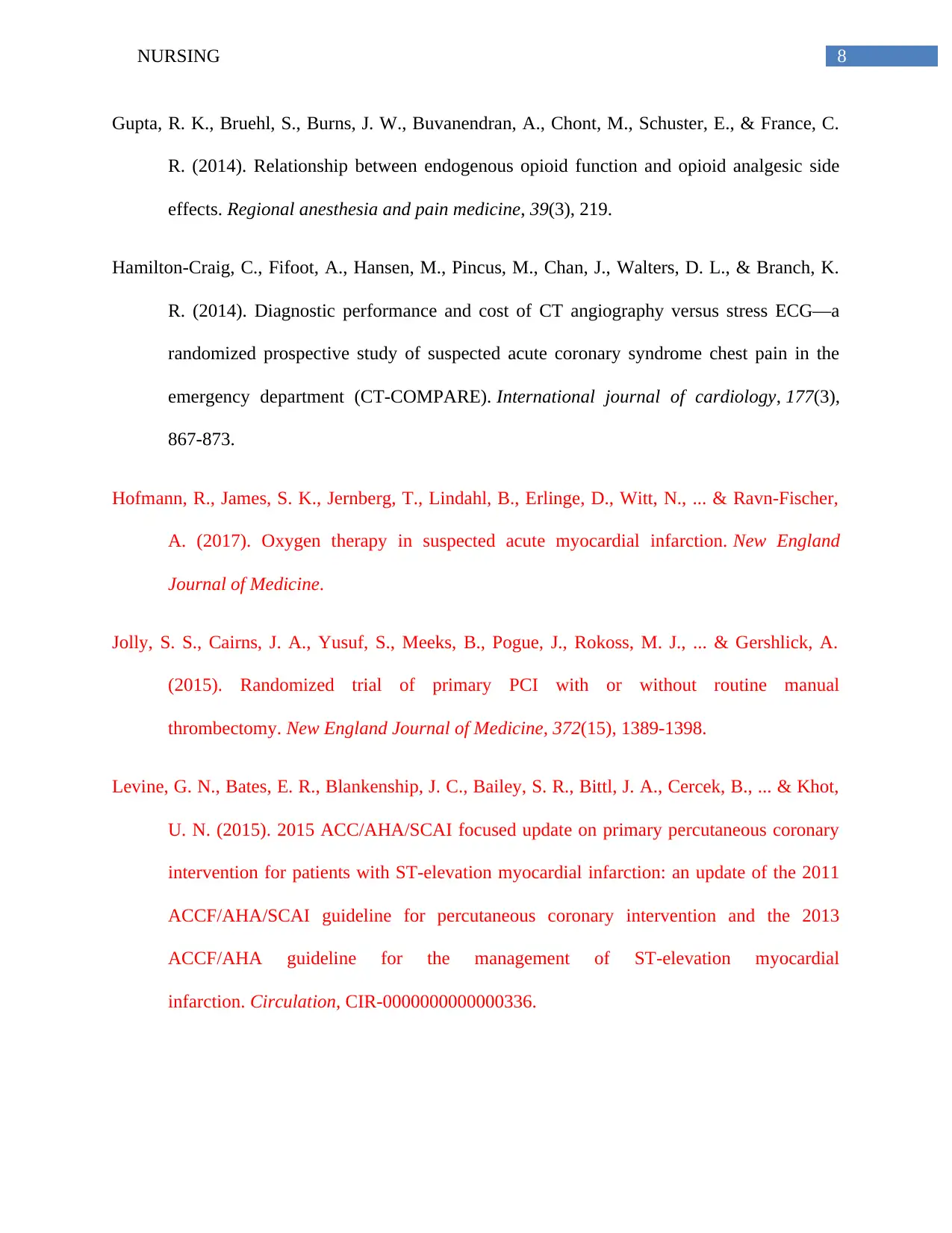
8NURSING
Gupta, R. K., Bruehl, S., Burns, J. W., Buvanendran, A., Chont, M., Schuster, E., & France, C.
R. (2014). Relationship between endogenous opioid function and opioid analgesic side
effects. Regional anesthesia and pain medicine, 39(3), 219.
Hamilton-Craig, C., Fifoot, A., Hansen, M., Pincus, M., Chan, J., Walters, D. L., & Branch, K.
R. (2014). Diagnostic performance and cost of CT angiography versus stress ECG—a
randomized prospective study of suspected acute coronary syndrome chest pain in the
emergency department (CT-COMPARE). International journal of cardiology, 177(3),
867-873.
Hofmann, R., James, S. K., Jernberg, T., Lindahl, B., Erlinge, D., Witt, N., ... & Ravn-Fischer,
A. (2017). Oxygen therapy in suspected acute myocardial infarction. New England
Journal of Medicine.
Jolly, S. S., Cairns, J. A., Yusuf, S., Meeks, B., Pogue, J., Rokoss, M. J., ... & Gershlick, A.
(2015). Randomized trial of primary PCI with or without routine manual
thrombectomy. New England Journal of Medicine, 372(15), 1389-1398.
Levine, G. N., Bates, E. R., Blankenship, J. C., Bailey, S. R., Bittl, J. A., Cercek, B., ... & Khot,
U. N. (2015). 2015 ACC/AHA/SCAI focused update on primary percutaneous coronary
intervention for patients with ST-elevation myocardial infarction: an update of the 2011
ACCF/AHA/SCAI guideline for percutaneous coronary intervention and the 2013
ACCF/AHA guideline for the management of ST-elevation myocardial
infarction. Circulation, CIR-0000000000000336.
Gupta, R. K., Bruehl, S., Burns, J. W., Buvanendran, A., Chont, M., Schuster, E., & France, C.
R. (2014). Relationship between endogenous opioid function and opioid analgesic side
effects. Regional anesthesia and pain medicine, 39(3), 219.
Hamilton-Craig, C., Fifoot, A., Hansen, M., Pincus, M., Chan, J., Walters, D. L., & Branch, K.
R. (2014). Diagnostic performance and cost of CT angiography versus stress ECG—a
randomized prospective study of suspected acute coronary syndrome chest pain in the
emergency department (CT-COMPARE). International journal of cardiology, 177(3),
867-873.
Hofmann, R., James, S. K., Jernberg, T., Lindahl, B., Erlinge, D., Witt, N., ... & Ravn-Fischer,
A. (2017). Oxygen therapy in suspected acute myocardial infarction. New England
Journal of Medicine.
Jolly, S. S., Cairns, J. A., Yusuf, S., Meeks, B., Pogue, J., Rokoss, M. J., ... & Gershlick, A.
(2015). Randomized trial of primary PCI with or without routine manual
thrombectomy. New England Journal of Medicine, 372(15), 1389-1398.
Levine, G. N., Bates, E. R., Blankenship, J. C., Bailey, S. R., Bittl, J. A., Cercek, B., ... & Khot,
U. N. (2015). 2015 ACC/AHA/SCAI focused update on primary percutaneous coronary
intervention for patients with ST-elevation myocardial infarction: an update of the 2011
ACCF/AHA/SCAI guideline for percutaneous coronary intervention and the 2013
ACCF/AHA guideline for the management of ST-elevation myocardial
infarction. Circulation, CIR-0000000000000336.
⊘ This is a preview!⊘
Do you want full access?
Subscribe today to unlock all pages.

Trusted by 1+ million students worldwide
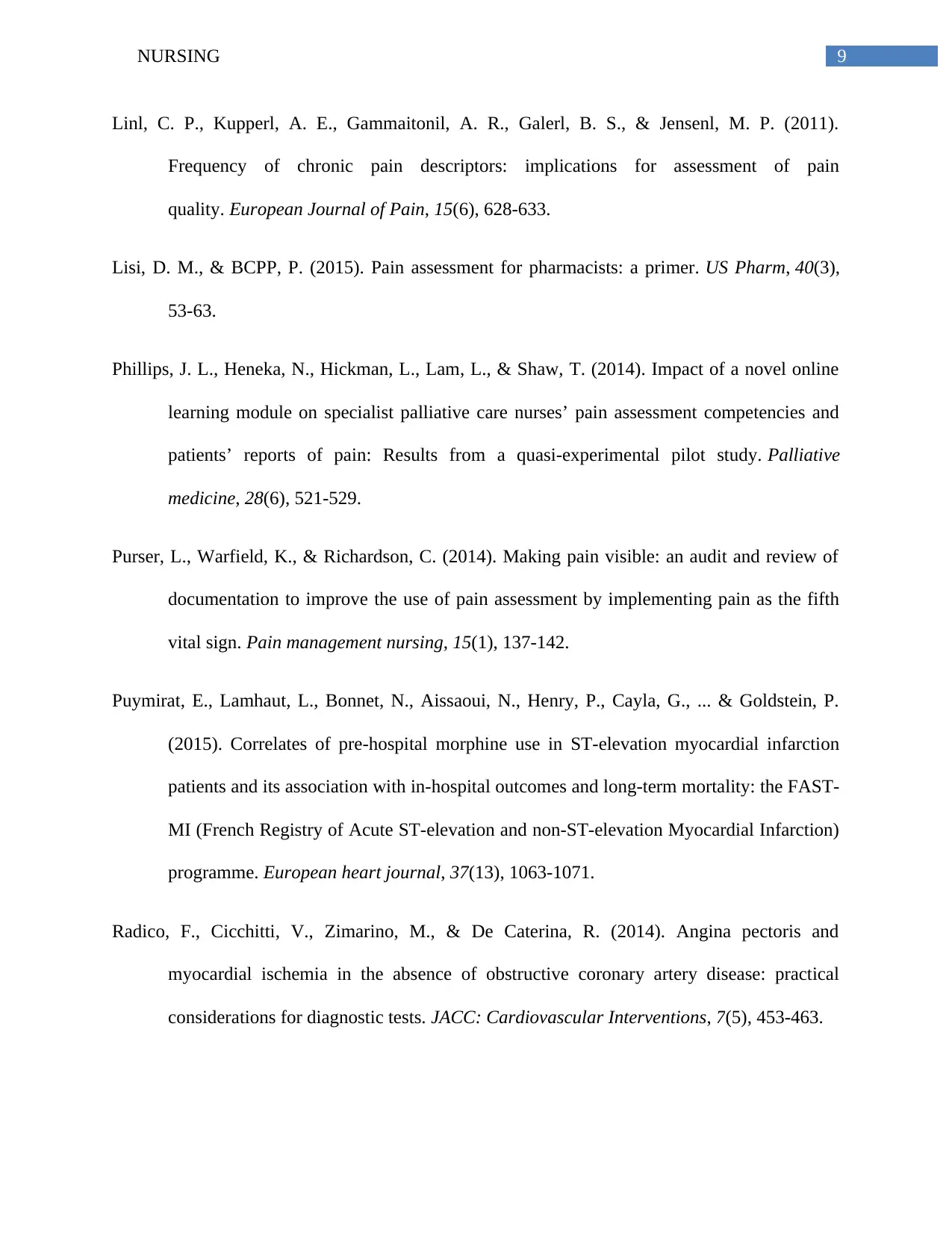
9NURSING
Linl, C. P., Kupperl, A. E., Gammaitonil, A. R., Galerl, B. S., & Jensenl, M. P. (2011).
Frequency of chronic pain descriptors: implications for assessment of pain
quality. European Journal of Pain, 15(6), 628-633.
Lisi, D. M., & BCPP, P. (2015). Pain assessment for pharmacists: a primer. US Pharm, 40(3),
53-63.
Phillips, J. L., Heneka, N., Hickman, L., Lam, L., & Shaw, T. (2014). Impact of a novel online
learning module on specialist palliative care nurses’ pain assessment competencies and
patients’ reports of pain: Results from a quasi-experimental pilot study. Palliative
medicine, 28(6), 521-529.
Purser, L., Warfield, K., & Richardson, C. (2014). Making pain visible: an audit and review of
documentation to improve the use of pain assessment by implementing pain as the fifth
vital sign. Pain management nursing, 15(1), 137-142.
Puymirat, E., Lamhaut, L., Bonnet, N., Aissaoui, N., Henry, P., Cayla, G., ... & Goldstein, P.
(2015). Correlates of pre-hospital morphine use in ST-elevation myocardial infarction
patients and its association with in-hospital outcomes and long-term mortality: the FAST-
MI (French Registry of Acute ST-elevation and non-ST-elevation Myocardial Infarction)
programme. European heart journal, 37(13), 1063-1071.
Radico, F., Cicchitti, V., Zimarino, M., & De Caterina, R. (2014). Angina pectoris and
myocardial ischemia in the absence of obstructive coronary artery disease: practical
considerations for diagnostic tests. JACC: Cardiovascular Interventions, 7(5), 453-463.
Linl, C. P., Kupperl, A. E., Gammaitonil, A. R., Galerl, B. S., & Jensenl, M. P. (2011).
Frequency of chronic pain descriptors: implications for assessment of pain
quality. European Journal of Pain, 15(6), 628-633.
Lisi, D. M., & BCPP, P. (2015). Pain assessment for pharmacists: a primer. US Pharm, 40(3),
53-63.
Phillips, J. L., Heneka, N., Hickman, L., Lam, L., & Shaw, T. (2014). Impact of a novel online
learning module on specialist palliative care nurses’ pain assessment competencies and
patients’ reports of pain: Results from a quasi-experimental pilot study. Palliative
medicine, 28(6), 521-529.
Purser, L., Warfield, K., & Richardson, C. (2014). Making pain visible: an audit and review of
documentation to improve the use of pain assessment by implementing pain as the fifth
vital sign. Pain management nursing, 15(1), 137-142.
Puymirat, E., Lamhaut, L., Bonnet, N., Aissaoui, N., Henry, P., Cayla, G., ... & Goldstein, P.
(2015). Correlates of pre-hospital morphine use in ST-elevation myocardial infarction
patients and its association with in-hospital outcomes and long-term mortality: the FAST-
MI (French Registry of Acute ST-elevation and non-ST-elevation Myocardial Infarction)
programme. European heart journal, 37(13), 1063-1071.
Radico, F., Cicchitti, V., Zimarino, M., & De Caterina, R. (2014). Angina pectoris and
myocardial ischemia in the absence of obstructive coronary artery disease: practical
considerations for diagnostic tests. JACC: Cardiovascular Interventions, 7(5), 453-463.
Paraphrase This Document
Need a fresh take? Get an instant paraphrase of this document with our AI Paraphraser
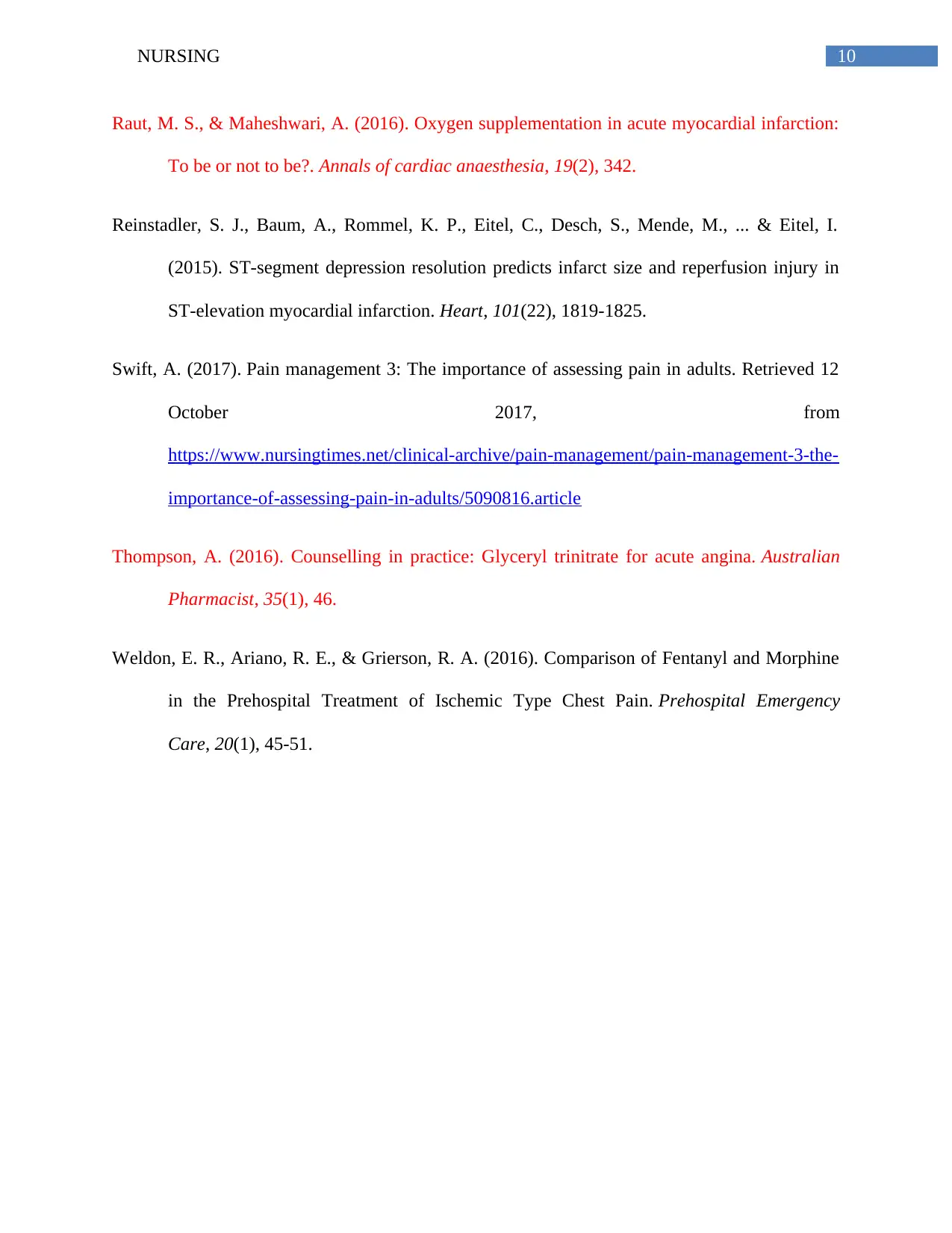
10NURSING
Raut, M. S., & Maheshwari, A. (2016). Oxygen supplementation in acute myocardial infarction:
To be or not to be?. Annals of cardiac anaesthesia, 19(2), 342.
Reinstadler, S. J., Baum, A., Rommel, K. P., Eitel, C., Desch, S., Mende, M., ... & Eitel, I.
(2015). ST-segment depression resolution predicts infarct size and reperfusion injury in
ST-elevation myocardial infarction. Heart, 101(22), 1819-1825.
Swift, A. (2017). Pain management 3: The importance of assessing pain in adults. Retrieved 12
October 2017, from
https://www.nursingtimes.net/clinical-archive/pain-management/pain-management-3-the-
importance-of-assessing-pain-in-adults/5090816.article
Thompson, A. (2016). Counselling in practice: Glyceryl trinitrate for acute angina. Australian
Pharmacist, 35(1), 46.
Weldon, E. R., Ariano, R. E., & Grierson, R. A. (2016). Comparison of Fentanyl and Morphine
in the Prehospital Treatment of Ischemic Type Chest Pain. Prehospital Emergency
Care, 20(1), 45-51.
Raut, M. S., & Maheshwari, A. (2016). Oxygen supplementation in acute myocardial infarction:
To be or not to be?. Annals of cardiac anaesthesia, 19(2), 342.
Reinstadler, S. J., Baum, A., Rommel, K. P., Eitel, C., Desch, S., Mende, M., ... & Eitel, I.
(2015). ST-segment depression resolution predicts infarct size and reperfusion injury in
ST-elevation myocardial infarction. Heart, 101(22), 1819-1825.
Swift, A. (2017). Pain management 3: The importance of assessing pain in adults. Retrieved 12
October 2017, from
https://www.nursingtimes.net/clinical-archive/pain-management/pain-management-3-the-
importance-of-assessing-pain-in-adults/5090816.article
Thompson, A. (2016). Counselling in practice: Glyceryl trinitrate for acute angina. Australian
Pharmacist, 35(1), 46.
Weldon, E. R., Ariano, R. E., & Grierson, R. A. (2016). Comparison of Fentanyl and Morphine
in the Prehospital Treatment of Ischemic Type Chest Pain. Prehospital Emergency
Care, 20(1), 45-51.
1 out of 11
Related Documents
Your All-in-One AI-Powered Toolkit for Academic Success.
+13062052269
info@desklib.com
Available 24*7 on WhatsApp / Email
![[object Object]](/_next/static/media/star-bottom.7253800d.svg)
Unlock your academic potential
Copyright © 2020–2025 A2Z Services. All Rights Reserved. Developed and managed by ZUCOL.





